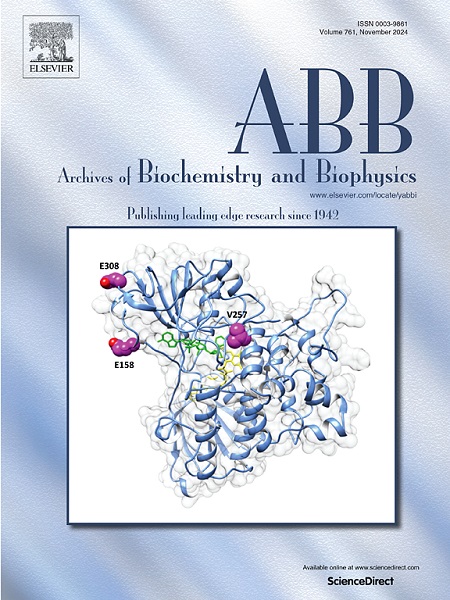比较分子动力学揭示了IrtAB-cMBT复合物在分枝杆菌铁摄取中的构象动力学
IF 3.8
3区 生物学
Q2 BIOCHEMISTRY & MOLECULAR BIOLOGY
引用次数: 0
摘要
结核分枝杆菌(Mtb)中的IrtAB转运体对于通过铁结合的羧粘菌素(cMBT)的进口获得铁至关重要,但控制底物识别和运输的分子机制仍未解决。在这里,我们采用了450-ns的分子动力学模拟来阐明IrtAB在无底物(apo)和底物结合(holo)状态下的构象动力学,揭示了支撑其运输周期的关键结构重排和残基特异性相互作用。对比分析表明,在全状态下,IrtA和IrtB亚基的不对称结构域运动促进了cMBT的易位,从而增强了构象灵活性。IrtA中的三个组氨酸残基(His356, His402, His407)在底物结合后发生了显著的位置移位(6-10 Å),形成了一个对cMBT识别至关重要的动态协调网络。配体表现出复杂的行为,包括在结合口袋内的3.5-4.0 Å向下运动和RMSD波动(0.5-5.0 Å),表明多种能量有利的结合模式。底物诱导的跨膜结构域的稳定与结合腔的逐渐脱水有关,而RMSF谱则突出了运输过程中跨膜螺旋的不对称灵活性。这些发现揭示了IrtAB的类似出口的结构如何被重新用于铁铁载体的进口,平衡结构刚性和构象可塑性,以实现有效的营养吸收。通过描述irtab介导的铁获取的机制基础,本研究为Mtb靶向这一途径提供了框架,为结核病的治疗干预提供了潜在的途径。本文章由计算机程序翻译,如有差异,请以英文原文为准。
Comparative molecular dynamics reveal the conformational dynamics of the IrtAB-cMBT complex in mycobacterial iron uptake
The IrtAB transporter in Mycobacterium tuberculosis (Mtb) is essential for iron acquisition through the import of iron-bound carboxymycobactin (cMBT), yet the molecular mechanisms governing substrate recognition and transport remain unresolved. Here, we employed 450-ns molecular dynamics simulations to elucidate the conformational dynamics of IrtAB in substrate-free (apo) and substrate-bound (holo) states, revealing key structural rearrangements and residue-specific interactions underpinning its transport cycle. Comparative analyses demonstrated enhanced conformational flexibility in the holo state, with asymmetric domain movements in IrtA and IrtB subunits facilitating cMBT translocation. Three histidine residues (His356, His402, His407) in IrtA undergone significant positional shifts (6–10 Å) upon substrate binding, forming a dynamic coordination network critical for cMBT recognition. The ligand exhibited complex behavior, including a 3.5–4.0 Å downward movement within the binding pocket and RMSD fluctuations (0.5–5.0 Å), indicative of multiple energetically favorable binding modes. Substrate-induced stabilization of the transmembrane domains correlates with progressive dehydration of the binding cavity, while RMSF profiles highlighted asymmetric flexibility in transmembrane helices during transport. These findings reveal how IrtAB's exporter-like architecture is repurposed for iron-siderophore import, balancing structural rigidity with conformational plasticity to enable efficient nutrient uptake. By delineating the mechanistic basis of IrtAB-mediated iron acquisition, this study provides a framework for targeting this pathway in Mtb, offering potential avenues for therapeutic intervention against tuberculosis.
求助全文
通过发布文献求助,成功后即可免费获取论文全文。
去求助
来源期刊

Archives of biochemistry and biophysics
生物-生化与分子生物学
CiteScore
7.40
自引率
0.00%
发文量
245
审稿时长
26 days
期刊介绍:
Archives of Biochemistry and Biophysics publishes quality original articles and reviews in the developing areas of biochemistry and biophysics.
Research Areas Include:
• Enzyme and protein structure, function, regulation. Folding, turnover, and post-translational processing
• Biological oxidations, free radical reactions, redox signaling, oxygenases, P450 reactions
• Signal transduction, receptors, membrane transport, intracellular signals. Cellular and integrated metabolism.
 求助内容:
求助内容: 应助结果提醒方式:
应助结果提醒方式:


